The demand for electric wheelchairs in the USA is expected to grow from USD 1.9 billion in 2025 to USD 4.7 billion by 2035, reflecting a CAGR of 9.4%. Electric wheelchairs, designed to provide mobility solutions for individuals with severe disabilities or mobility impairments, are seeing increasing adoption due to advancements in technology, improved battery life, and greater affordability. As the aging population continues to grow, along with the increasing prevalence of chronic conditions like arthritis, stroke, and neurological disorders, the demand for electric wheelchairs is expected to rise significantly.
Technological innovations, such as smarter control systems, improved comfort features, and customizable designs, will further enhance the appeal of electric wheelchairs. Additionally, as healthcare systems focus on patient independence, quality of life, and mobility assistance, electric wheelchairs are increasingly becoming a staple in home healthcare solutions. The growing preference for personalized mobility aids will further drive the market expansion over the next decade.
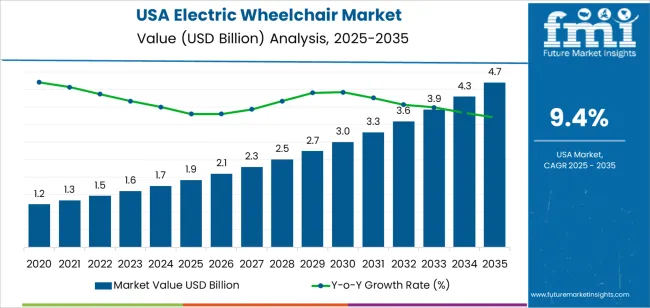
Between 2025 and 2030, the demand for electric wheelchairs in the USA will grow from USD 1.9 billion to USD 3.0 billion, contributing an increase of USD 1.1 billion. This initial phase will see significant acceleration driven by increased adoption of electric wheelchairs by individuals with mobility impairments seeking more independent and efficient mobility solutions. As more people experience the benefits of electric wheelchairs in terms of comfort, ease of use, and battery efficiency, the market is expected to grow rapidly during these early years. Additionally, advancements in technology and the reduction in device costs will make electric wheelchairs more accessible to a broader population, driving higher adoption.
From 2030 to 2035, the market will grow from USD 3.0 billion to USD 4.7 billion, contributing USD 1.7 billion in growth. This period will see a more mature growth, reflecting increased market saturation as electric wheelchairs become a standard mobility solution in both residential settings and healthcare facilities. The demand will be fueled by continuous technological improvements, including longer battery life, advanced customization options, and integration with smart home technologies. Additionally, rising healthcare costs, along with improved healthcare policies supporting independent living, will ensure steady demand for electric wheelchairs, although the growth rate may moderate slightly compared to the earlier phase. Overall, the market will continue to experience strong expansion due to the ongoing aging population, rising disability rates, and technological innovations in the electric wheelchair segment.
| Metric | Value |
|---|---|
| Industry Sales Value (2025) | USD 1.9 billion |
| Industry Forecast Value (2035) | USD 4.7 billion |
| Industry Forecast CAGR (2025-2035) | 9.4% |
Demand for electric wheelchairs in the USA is rising due to the ageing of the population, increasing prevalence of mobility impairing conditions and shifting consumer expectations for independence and comfort. As more individuals live longer and develop chronic conditions such as arthritis, spinal cord injuries and neurodegenerative disorders, the need for powered mobility aids grows. Electric wheelchairs enable users with limited upper body strength or endurance to move more freely in both indoor and outdoor environments, supporting quality of life and social engagement.
Another significant driver is technological advancement and healthcare coverage trends that enhance accessibility to powered mobility devices. Improvements in battery life, lightweight frame design, adjustable seating, and smart controls make electric wheelchairs more appealing to users seeking customized mobility solutions. In addition, policies around Medicare and Medicaid reimbursement, along with demand from home care and assisted living facilities, boost market growth. Challenges include high initial cost, variability in coverage, and regulatory complexities for device classification. Nevertheless, the convergence of demographic trends, increased disability awareness and innovation in mobility technology suggests that demand for electric wheelchairs in the USA will continue to grow.
The demand for electric wheelchairs in the USA is driven by product type and end-user segment. The leading product type is rear wheel drive, capturing 43% of the market share, while hospitals and clinics are the dominant end-user segment, accounting for 46.2% of the demand. Electric wheelchairs are essential for providing mobility solutions to individuals with limited mobility, and the demand for these devices continues to grow as the aging population increases and healthcare needs evolve. The preference for rear-wheel drive wheelchairs is driven by their stability, smooth ride, and ease of maneuverability, while hospitals and clinics remain major buyers due to the need for durable, reliable mobility aids for patient care.
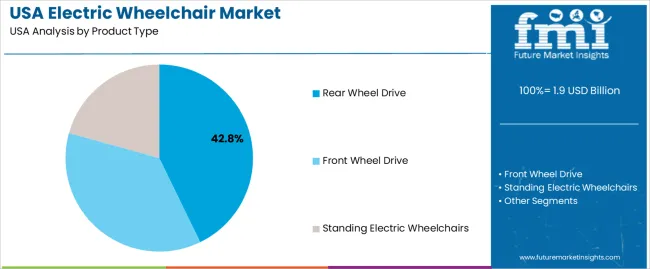
Rear wheel drive electric wheelchairs lead the market in the USA, capturing 43% of the demand. Rear wheel drive models are popular because they offer enhanced stability and provide a smooth, comfortable ride for users. These wheelchairs are designed for better traction and power efficiency, making them ideal for both indoor and outdoor use. The rear-wheel design allows for easy maneuverability and helps users navigate obstacles more effectively.
The demand for rear-wheel drive electric wheelchairs is driven by their reliability, comfort, and performance. They are especially favored in healthcare settings, such as hospitals and clinics, where patients require durable and efficient mobility aids. Additionally, rear-wheel drive wheelchairs are suited for individuals with long-term mobility needs, as they offer increased stability and better handling, particularly for users with more severe mobility limitations. As the need for reliable and comfortable mobility aids grows, rear-wheel drive electric wheelchairs are expected to remain the dominant product type in the market.

Hospitals and clinics are the largest end-user segment for electric wheelchairs in the USA, accounting for 46.2% of the market share. These healthcare facilities require high-quality, durable, and easy-to-use wheelchairs for patient mobility and care. Electric wheelchairs play a vital role in improving the quality of life for individuals with mobility impairments, particularly in hospital settings where patients often need support during recovery or rehabilitation.
The demand from hospitals and clinics is driven by the need for reliable and efficient mobility devices that can accommodate a wide range of patient needs. These institutions require wheelchairs that can support patients in various healthcare scenarios, from rehabilitation to long-term care. The increasing aging population and the rise in chronic conditions that affect mobility, such as neurological disorders, are further contributing to the growth of the electric wheelchair market in healthcare settings. As hospitals and clinics continue to focus on improving patient care and comfort, they will remain the primary end-users of electric wheelchairs in the USA.
Demand for electric wheelchairs in the USA is driven by the growing number of adults with mobility impairments, an ageing population, and a growing preference for independent living. A large share of the USA mobility-aid market is dominated by powered wheelchair solutions, which handle more complex needs than manual chairs. Advances in battery technology, smart mobility features, and home care focus are enhancing appeal. At the same time, high product costs, reimbursement challenges, and variable access across care settings moderate growth. These dynamics define the market’s structure and volume potential.
What Are the Primary Growth Drivers for Electric Wheelchair Demand in the United States?
Several drivers support growth in the USA electric wheelchair segment. First, the increasing population of older adults and individuals with chronic conditions such as arthritis, diabetes-related neuropathy, spinal cord injuries, and stroke create a larger base of mobility-aid users. Second, technological innovations such as lightweight frames, longer-range batteries, foldable designs, and integration with smart-home systems make electric wheelchairs more practical for home and community use. Third, increased healthcare expenditure, home-care preference, and awareness of mobility device options drive uptake. Additionally, favourable policies and veteran care programs support device access and market expansion.
What Are the Key Restraints Affecting Electric Wheelchair Demand in the United States?
Despite strong growth, the market faces notable restraints. High purchase costs and maintenance expenses can limit adoption among cost-sensitive consumers or those relying on limited insurance coverage. Reimbursement and insurance approval hurdles, including variability between insurers and requirements for candidacy, can delay or limit access. Access to specialised surgical centres and audiological rehabilitation may be uneven across regions, restricting patient access. Additionally, the pool of undiagnosed individuals or those unwilling to undergo surgery limits potential volume growth.
What Are the Key Trends Shaping Electric Wheelchair Demand in the United States?
Key trends include the rising adoption of “smart” powered wheelchairs equipped with IoT connectivity, sensors, remote monitoring, and adjustable power settings that improve user autonomy and safety. There is also growing preference for travel-friendly or foldable electric wheelchair models catering to active users who value portability. The home-care segment is expanding rapidly, driving manufacturers to design devices for personal, everyday use beyond institutional settings. Sustainable and energy-efficient designs are gaining attention, too, with lithium-ion batteries and lighter materials enabling longer range and lower overall weight.
The demand for electric wheelchairs in the USA is growing as the aging population increases, along with the rising prevalence of mobility issues due to chronic conditions such as arthritis, diabetes, and neurological disorders. Electric wheelchairs offer greater independence and mobility for individuals with limited physical capabilities, making them a vital component of healthcare solutions. Factors such as advancements in wheelchair technology, improved access to healthcare, and a shift towards more user-friendly, efficient, and comfortable devices are driving this growth. Regional differences in demand are influenced by the prevalence of elderly populations, healthcare infrastructure, and the availability of specialized products in various areas of the country. Below is an analysis of the demand for electric wheelchairs across different regions of the USA.
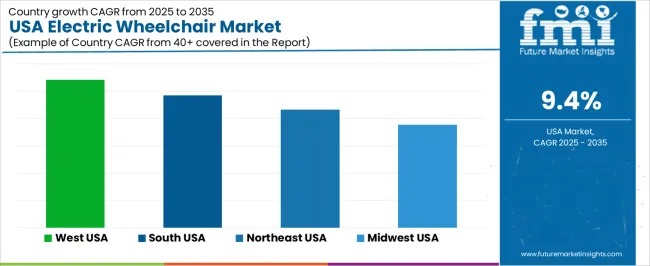
| Region | CAGR (2025-2035) |
|---|---|
| West | 10.8% |
| South | 9.7% |
| Northeast | 8.7% |
| Midwest | 7.5% |
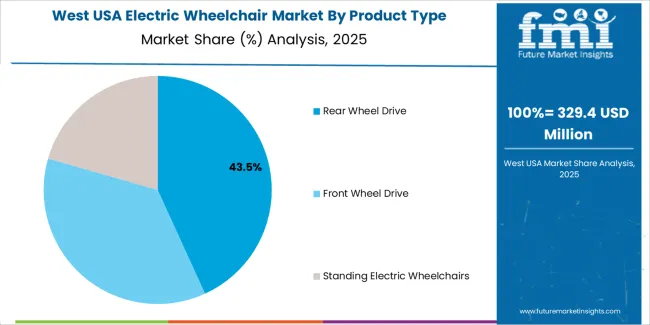
The West leads the demand for electric wheelchairs in the USA with a CAGR of 10.8%. This can be attributed to the region’s large population of elderly individuals, particularly in states like California, which has one of the largest elderly populations in the country. The West is also home to a high concentration of healthcare facilities and senior care services, where electric wheelchairs are an essential mobility aid for patients and residents.
Additionally, the West has seen rapid advancements in wheelchair technology, resulting in more comfortable, durable, and user-friendly electric wheelchairs that meet the needs of individuals with varying mobility levels. The region's focus on innovation and healthcare access, along with its growing elderly population, makes it a key market for electric wheelchair demand.

The South shows strong demand for electric wheelchairs with a CAGR of 9.7%. States like Texas, Florida, and Georgia are experiencing population growth, particularly among the elderly. As the aging population increases, so does the need for mobility solutions such as electric wheelchairs to support the independence and quality of life of seniors.
Additionally, the South’s warmer climate and higher rates of chronic health conditions like diabetes and arthritis drive the adoption of electric wheelchairs, as these conditions often lead to mobility impairments. The region's growing healthcare infrastructure, including senior care centers and rehabilitation facilities, further supports the demand for electric wheelchairs. With the rise in demand for home care services and the increasing focus on aging in place, the South will continue to see steady growth in the electric wheelchair market.
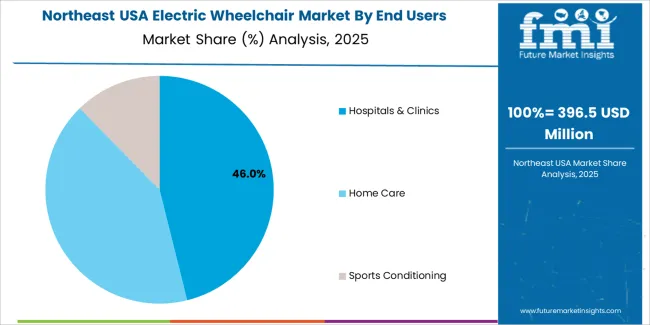
The Northeast shows steady demand for electric wheelchairs with a CAGR of 8.7%. The region has a significant elderly population, particularly in cities like New York, Boston, and Philadelphia, where chronic health conditions and mobility challenges are more prevalent. The demand for electric wheelchairs is driven by the region’s aging demographics and the need for reliable mobility aids for those with limited physical capabilities.
While growth is slower compared to the West and South, the Northeast's healthcare system is advanced, with numerous hospitals, rehabilitation centers, and home healthcare services that support the need for electric wheelchairs. The region's focus on improving the quality of life for seniors and expanding healthcare accessibility ensures that demand for electric wheelchairs will remain steady.
The Midwest shows moderate growth in the demand for electric wheelchairs with a CAGR of 7.5%. The region, which includes states like Illinois, Michigan, and Ohio, has a large number of elderly residents and individuals with chronic conditions that impact mobility. While the Midwest has strong healthcare infrastructure, the growth rate for electric wheelchairs is slower compared to the West and South due to a lower concentration of urban centers with specialized services.
Nevertheless, as the Midwest’s population continues to age, the demand for electric wheelchairs is expected to grow steadily. The rise in chronic conditions such as diabetes and the increasing focus on home healthcare and aging in place will contribute to the continued adoption of electric wheelchairs in the region. As more people seek independence and mobility solutions, the Midwest will see continued demand for electric wheelchairs.
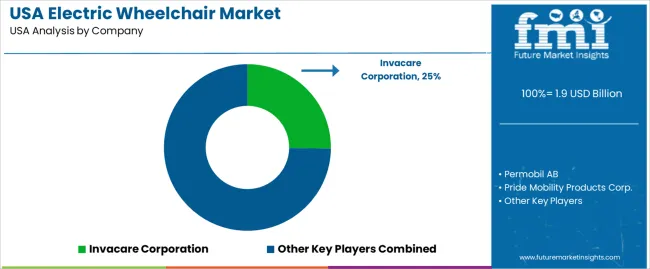
The demand for electric wheelchairs in the United States is growing as the aging population and individuals with mobility impairments increasingly seek solutions that offer improved independence, comfort, and convenience. Companies like Invacare Corporation (holding approximately 25.2% market share), Permobil AB, Pride Mobility Products Corp., Sunrise Medical LLC, and Drive DeVilbiss Healthcare are key players in this industry. As healthcare professionals and patients prioritize mobility and quality of life, the demand for electric wheelchairs continues to rise, with advancements in technology and design enhancing the appeal of these devices.
Competition in the electric wheelchair industry is driven by product innovation, comfort, battery life, and ease of use. Companies focus on developing wheelchairs with features such as adjustable seating, customizable controls, and longer-lasting batteries to enhance user experience. Additionally, there is a growing emphasis on lightweight materials and compact designs for greater portability, making electric wheelchairs more versatile for users with active lifestyles. Another competitive advantage lies in offering specialized solutions for specific needs, such as standing wheelchairs or models designed for outdoor use with off-road capabilities. Marketing materials often highlight key features such as maneuverability, safety features, ease of transportation, and customization options. By aligning their products with the increasing demand for functional, reliable, and comfortable mobility solutions, these companies aim to strengthen their position in the USA electric wheelchair industry.
| Items | Details |
|---|---|
| Quantitative Units | USD Billion |
| Regions Covered | USA |
| Product Type | Front Wheel Drive, Rear Wheel Drive, Standing Electric Wheelchairs |
| End Users | Hospitals & Clinics, Home Care, Sports Conditioning |
| Key Companies Profiled | Invacare Corporation, Permobil AB, Pride Mobility Products Corp., Sunrise Medical LLC, Drive DeVilbiss Healthcare |
| Additional Attributes | The market analysis includes dollar sales by product type and end-user categories. It also covers regional demand trends in the USA, particularly driven by the rising demand for mobility solutions in hospitals, clinics, and home care settings. The competitive landscape highlights key manufacturers focusing on innovations in electric wheelchair designs, functionality, and mobility. Trends in the growing demand for advanced, customizable electric wheelchairs for different needs, including sports conditioning and rehabilitation, are explored, along with improvements in battery technology, user comfort, and durability. |
The global demand for electric wheelchair in USA is estimated to be valued at USD 1.9 billion in 2025.
The market size for the demand for electric wheelchair in USA is projected to reach USD 4.7 billion by 2035.
The demand for electric wheelchair in USA is expected to grow at a 9.4% CAGR between 2025 and 2035.
The key product types in demand for electric wheelchair in USA are rear wheel drive, front wheel drive and standing electric wheelchairs.
In terms of end users, hospitals & clinics segment to command 46.2% share in the demand for electric wheelchair in USA in 2025.






Our Research Products

The "Full Research Suite" delivers actionable market intel, deep dives on markets or technologies, so clients act faster, cut risk, and unlock growth.

The Leaderboard benchmarks and ranks top vendors, classifying them as Established Leaders, Leading Challengers, or Disruptors & Challengers.

Locates where complements amplify value and substitutes erode it, forecasting net impact by horizon

We deliver granular, decision-grade intel: market sizing, 5-year forecasts, pricing, adoption, usage, revenue, and operational KPIs—plus competitor tracking, regulation, and value chains—across 60 countries broadly.

Spot the shifts before they hit your P&L. We track inflection points, adoption curves, pricing moves, and ecosystem plays to show where demand is heading, why it is changing, and what to do next across high-growth markets and disruptive tech

Real-time reads of user behavior. We track shifting priorities, perceptions of today’s and next-gen services, and provider experience, then pace how fast tech moves from trial to adoption, blending buyer, consumer, and channel inputs with social signals (#WhySwitch, #UX).

Partner with our analyst team to build a custom report designed around your business priorities. From analysing market trends to assessing competitors or crafting bespoke datasets, we tailor insights to your needs.
Supplier Intelligence
Discovery & Profiling
Capacity & Footprint
Performance & Risk
Compliance & Governance
Commercial Readiness
Who Supplies Whom
Scorecards & Shortlists
Playbooks & Docs
Category Intelligence
Definition & Scope
Demand & Use Cases
Cost Drivers
Market Structure
Supply Chain Map
Trade & Policy
Operating Norms
Deliverables
Buyer Intelligence
Account Basics
Spend & Scope
Procurement Model
Vendor Requirements
Terms & Policies
Entry Strategy
Pain Points & Triggers
Outputs
Pricing Analysis
Benchmarks
Trends
Should-Cost
Indexation
Landed Cost
Commercial Terms
Deliverables
Brand Analysis
Positioning & Value Prop
Share & Presence
Customer Evidence
Go-to-Market
Digital & Reputation
Compliance & Trust
KPIs & Gaps
Outputs
Full Research Suite comprises of:
Market outlook & trends analysis
Interviews & case studies
Strategic recommendations
Vendor profiles & capabilities analysis
5-year forecasts
8 regions and 60+ country-level data splits
Market segment data splits
12 months of continuous data updates
DELIVERED AS:
PDF EXCEL ONLINE
USA Electric Vehicle Reducer Market Outlook – Share, Growth & Forecast 2025-2035
Electric Wheelchair Market Analysis - Growth & Forecast 2025 to 2035
Demand for Electric Wheelchair in Japan Size and Share Forecast Outlook 2025 to 2035
Demand for Electric Stakebed Truck in USA Size and Share Forecast Outlook 2025 to 2035
Demand for All Electric Multipurpose Goods Vehicle in USA Size and Share Forecast Outlook 2025 to 2035
Electric Aircraft Onboard Sensors Market Size and Share Forecast Outlook 2025 to 2035
Electrical Label Market Size and Share Forecast Outlook 2025 to 2035
Electric Round Sprinklers Market Size and Share Forecast Outlook 2025 to 2035
Electric Cloth Cutting Scissors Market Size and Share Forecast Outlook 2025 to 2035
Electrical Insulation Materials Market Size and Share Forecast Outlook 2025 to 2035
Electric Aircraft Sensors Market Size and Share Forecast Outlook 2025 to 2035
Electric Traction Motor Market Forecast Outlook 2025 to 2035
Electric Vehicle Sensor Market Forecast and Outlook 2025 to 2035
Electric Vehicle Motor Market Forecast and Outlook 2025 to 2035
Electric Off-Road ATVs & UTVs Market Size and Share Forecast Outlook 2025 to 2035
Electric Blind Rivet Gun Market Size and Share Forecast Outlook 2025 to 2035
Electric Fireplace Market Size and Share Forecast Outlook 2025 to 2035
Electric Glider Market Size and Share Forecast Outlook 2025 to 2035
Electric Vehicle Battery Conditioners Market Size and Share Forecast Outlook 2025 to 2035
Electric Power Steering Motors Market Size and Share Forecast Outlook 2025 to 2035

Thank you!
You will receive an email from our Business Development Manager. Please be sure to check your SPAM/JUNK folder too.
Chat With
MaRIA